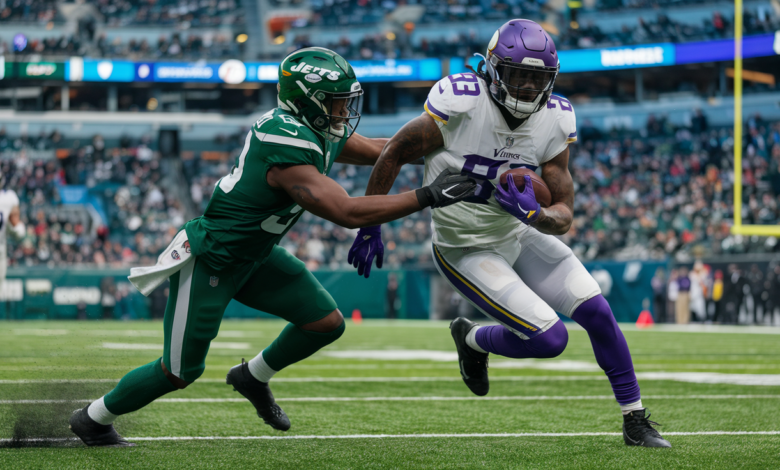New York Jets vs Minnesota Vikings Match Player Stats: A Deep Dive into Game Performance

The New York Jets vs Minnesota Vikings match player stats offer an insightful look into how both teams performed on the field during their intense matchup. With both teams bringing strong performances, analyzing these stats can give us a clearer picture of what happened and why the Vikings emerged victorious. From key players like Aaron Rodgers and Garrett Wilson for the Jets to Justin Jefferson and Andrew Van Ginkel for the Vikings, the game’s stats tell an exciting story of turnovers, touchdowns, and big plays.
In this game, the New York Jets were looking to bounce back from their previous losses, while the Minnesota Vikings aimed to continue their undefeated streak. The performance of the players is crucial in understanding how the game unfolded, and by breaking down the individual stats, we can highlight moments that were game-changers. Aaron Rodgers, despite having a tough game with interceptions, showed flashes of his usual talent, while the Vikings defense, particularly Andrew Van Ginkel, made sure to capitalize on the Jets’ mistakes. By looking deeper into the individual player stats from this match, we can see the pivotal roles played by both teams, making this analysis essential for any football fan or enthusiast.
- A Detailed Breakdown of New York Jets vs Minnesota Vikings Match Player Stats
- How Aaron Rodgers' Stats Impacted the New York Jets vs Minnesota Vikings Game
- Key Player Performances in the New York Jets vs Minnesota Vikings Match
- Turnovers and Big Plays: The Role of Stats in the Jets vs Vikings Showdown
- New York Jets vs Minnesota Vikings Match Player Stats: Who Made the Difference?
- A Closer Look at Garrett Wilson’s Contribution in the Jets vs Vikings Game
- Defensive Play: How Andrew Van Ginkel’s Stats Helped Secure the Vikings' Win
- Why Team Stats Matter: Understanding the Jets vs Vikings Match Player Stats
- New York Jets vs Minnesota Vikings: How Rushing and Passing Stats Defined the Game
- Impact of Key Stats: How the Vikings Overcame the Jets in Their Matchup
- Conclusion
- FAQs
A Detailed Breakdown of New York Jets vs Minnesota Vikings Match Player Stats
The New York Jets vs Minnesota Vikings match was full of action, with significant player performances that determined the outcome. Looking at the player stats, we can identify the key moments that impacted the game. Aaron Rodgers, despite his efforts, threw multiple interceptions, which played a big role in the Jets’ defeat. On the other hand, Minnesota’s defense, led by Andrew Van Ginkel, was relentless and capitalized on the Jets’ mistakes. The stats of the game show that while both teams had similar total yards, the Vikings’ ability to convert turnovers into points made a clear difference. This detailed breakdown highlights how individual player stats directly shaped the game’s flow and outcome.
How Aaron Rodgers’ Stats Impacted the New York Jets vs Minnesota Vikings Game
Aaron Rodgers’ performance in the New York Jets vs Minnesota Vikings match was a defining factor in the Jets’ loss. With 244 passing yards, Rodgers had a decent output, but his 3 interceptions proved costly. These turnovers disrupted the Jets’ rhythm and gave Minnesota valuable field position. His inability to avoid mistakes and manage the game effectively allowed the Vikings to maintain control. Despite throwing 2 touchdowns, Rodgers’ stats show that turnovers were a major issue. The Vikings’ defense, particularly Andrew Van Ginkel, capitalized on these mistakes, which helped them maintain their lead throughout the game. Ultimately, Rodgers’ stats illustrate the importance of minimizing errors in high-stakes matchups.
Key Player Performances in the New York Jets vs Minnesota Vikings Match
In the New York Jets vs Minnesota Vikings match, standout player performances helped shape the game’s result. For the Jets, Garrett Wilson was a key contributor, accumulating 101 receiving yards and a touchdown. His ability to make key receptions kept the Jets in the game, even when their offense struggled. On the other side, Justin Jefferson continued to be a reliable target for the Vikings, with 92 yards on 6 catches. However, it was Andrew Van Ginkel’s defensive performance that truly stood out. His 63-yard interception return for a touchdown was a pivotal moment that shifted momentum in the Vikings’ favor. These key performances from both teams highlight the importance of individual contributions in a team sport.
Turnovers and Big Plays: The Role of Stats in the Jets vs Vikings Showdown
Turnovers and big plays were major factors in the New York Jets vs Minnesota Vikings showdown. The Vikings capitalized on the Jets’ mistakes, particularly with Aaron Rodgers throwing 3 interceptions. One of those interceptions, returned by Andrew Van Ginkel for a touchdown, shifted the momentum and gave the Vikings a commanding lead. On the other hand, the Jets’ inability to convert big plays limited their ability to stay in the game. The Vikings’ defense was aggressive, forcing turnovers and limiting the Jets’ offensive options. While the Jets had similar total yards, the Vikings’ ability to turn defensive plays into scoring opportunities made all the difference. Stats show that turnovers and big plays ultimately determined the winner.
New York Jets vs Minnesota Vikings Match Player Stats: Who Made the Difference?
In the New York Jets vs Minnesota Vikings match, player stats reveal who made the real difference in the game. Aaron Rodgers’ turnovers were crucial in giving the Vikings a significant advantage. His 3 interceptions, including one returned for a touchdown by Andrew Van Ginkel, were costly. The Vikings’ defense was the real game-changer, making sure to take full advantage of these turnovers. On the offensive side, Garrett Wilson’s performance for the Jets stood out with his 101 receiving yards and touchdown, but it wasn’t enough to overcome the turnovers. The Vikings’ defense played a major role in their 23-17 victory, and player stats show how these critical moments shaped the game’s outcome.
A Closer Look at Garrett Wilson’s Contribution in the Jets vs Vikings Game
Garrett Wilson played a pivotal role in the New York Jets vs Minnesota Vikings matchup with an impressive performance. He recorded 101 yards on 13 receptions, including a touchdown, which made him the Jets’ most reliable offensive weapon. Despite the team’s struggles, Wilson’s ability to make clutch catches helped keep the Jets competitive. His 1-yard touchdown reception in the fourth quarter brought the Jets within 3 points, but it was too little, too late. While Wilson’s stats were strong, the Jets’ overall performance was hindered by turnovers and missed opportunities. His individual contribution was valuable, but it wasn’t enough to overcome the Vikings’ defense, which ultimately secured the win.
Defensive Play: How Andrew Van Ginkel’s Stats Helped Secure the Vikings’ Win
Andrew Van Ginkel’s defensive performance in the New York Jets vs Minnesota Vikings game was a key factor in the Vikings’ victory. Van Ginkel’s 63-yard interception return for a touchdown was a game-changing moment. His ability to capitalize on Aaron Rodgers’ mistake shifted the momentum in favor of the Vikings. Additionally, his overall defensive play, including a sack, kept pressure on the Jets throughout the game. Van Ginkel’s stats highlight the importance of defensive playmaking in determining the outcome of a game. His interception was a turning point, and his overall performance helped the Vikings maintain their perfect record, proving the significance of strong defense in high-stakes games.
Why Team Stats Matter: Understanding the Jets vs Vikings Match Player Stats
Team stats are essential to understanding the outcome of the New York Jets vs Minnesota Vikings matchup. Despite the Jets and Vikings having similar total yards—254 and 253 yards, respectively—the key difference came in turnovers. The Jets committed 3 turnovers, which directly led to points for the Vikings. The Vikings, with 2 turnovers, managed to limit the damage and convert their turnovers into scoring opportunities. Stats such as time of possession, penalties, and rushing yards also played significant roles. The Vikings had a slight edge in possession time, and their defense dominated, especially in critical moments. Understanding these team stats provides a clearer picture of why the Vikings came out on top in this matchup.
New York Jets vs Minnesota Vikings: How Rushing and Passing Stats Defined the Game
Rushing and passing stats were pivotal in determining the outcome of the New York Jets vs Minnesota Vikings matchup. The Jets’ running game struggled, with Breece Hall gaining just 23 yards on 9 carries. This limited the Jets’ offensive options and put more pressure on Aaron Rodgers to make plays through the air. On the Vikings’ side, their rushing attack, led by Ty Chandler, was more effective, with 82 yards on 14 carries. Passing stats were equally important, with Aaron Rodgers throwing for 244 yards but committing 3 interceptions. The Vikings’ passing game was more efficient, and despite fewer yards, their ability to control the ball and avoid turnovers allowed them to win. The stats show how rushing and passing both played crucial roles in the Vikings’ 23-17 win.
Impact of Key Stats: How the Vikings Overcame the Jets in Their Matchup
The New York Jets vs Minnesota Vikings matchup was shaped by key stats that ultimately decided the winner. The Vikings capitalized on the Jets’ turnovers, including a critical interception return for a touchdown by Andrew Van Ginkel. While both teams had similar yardage, the Vikings’ ability to avoid costly mistakes and their strong defensive play made the difference. Aaron Rodgers’ 3 interceptions were a major factor in the Jets’ defeat, while the Vikings’ ability to maintain control with fewer turnovers and a more effective defense allowed them to secure the win. Key stats such as turnovers, time of possession, and defensive plays illustrate how the Vikings overcame the Jets in this close, competitive game.
Conclusion
In conclusion, the New York Jets vs Minnesota Vikings match was a close game, but turnovers played a big part in deciding the winner. Aaron Rodgers’ mistakes, like throwing 3 interceptions, allowed the Vikings to take control. Even though Garrett Wilson and other players gave their best, the Vikings’ defense was just too strong, especially with key plays from Andrew Van Ginkel. The game showed how important it is to limit mistakes and take advantage of big moments.
The Vikings showed why stats like turnovers, defensive plays, and efficiency matter in a football game. With fewer turnovers and solid plays, they secured a well-deserved win. The match was exciting to watch, and player performances on both sides were impressive. The game highlighted how crucial every play, whether offensive or defensive, can change the outcome of a game.
FAQs
Q: What was the final score of the New York Jets vs Minnesota Vikings match?
A: The final score was 23-17 in favor of the Minnesota Vikings.
Q: Who had the most receiving yards for the New York Jets?
A: Garrett Wilson had the most receiving yards with 101 yards on 13 catches.
Q: How many interceptions did Aaron Rodgers throw in the game?
A: Aaron Rodgers threw 3 interceptions during the game.
Q: Which player returned an interception for a touchdown in the match?
A: Andrew Van Ginkel returned an interception for a 63-yard touchdown.
Q: What was the total yardage for both teams in the game?
A: The Jets had 254 yards, and the Vikings had 253 yards.




